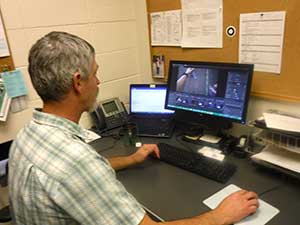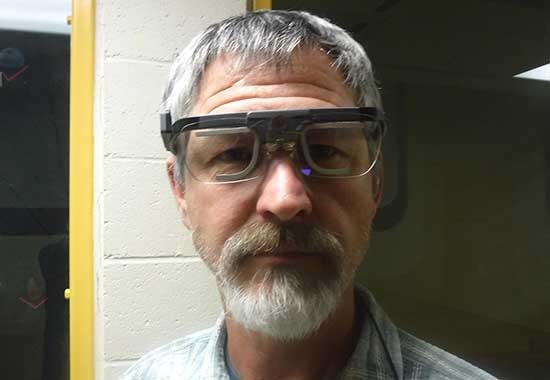University Communications and Marketing
December 21, 2017
Outdoor Adventure Leadership Assistant Professor Clinton Culp models Tobii eye-tracking glasses worn by research participants while climbing MSUB’s rock wall. (Photo by Eric Brown)
MSUB professors using eye-tracking technology on rock wall for cutting-edge research
Contacts:
University Relations, 657-2266
MSU BILLINGS NEWS SERVICES — Two MSU Billings College of Allied Health Professionals professors are conducting a research project using eye-tracking glasses, the university’s rock wall and a dozen student-participants.
Outdoor Adventure Leadership Assistant Professor Clinton Culp and Health and Human Performance Assistant Professor Alex Shafer, who have offices a few steps apart in the campus’ physical education building, began working on this project over the summer. By the end of summer 2018, they hope to have a research paper ready for submission to a peer-reviewed journal.
“We’ve got enough data for at least three different papers,” Culp said in reference to the vast amounts of information they are collecting for this study.

The participants in the study are equal numbers of males and females, further categorized as being self-reported experienced rock climbers or novice rock climbers.
The key component in this research is the Tobii eye-tracking glasses, which have recently found application in the military, sports and marketing. One pair, along with the analyzing software, costs about $17,000.
“We are employing eye-tracking technology that allows us to see part of the decision-making process,” Shafer said. “We can see where they [the research participants] are looking before they make a move.”
Each participant climbed the rock wall while wearing the glasses, which transmitted the data to a computer where it can be viewed and recorded.
“The glasses have a wide-angle camera that faces out; inside the glasses there is a little gray frame that has two cameras focused on each eye and looking at the retina,” Culp said. “Once it’s calibrated, the computer is able to track the retinas’ movements and overlays a red circle on the outward-facing image that’s being recorded at the same time.”
This technology allows the researchers to observe what a climber is looking at, and for how long, while ascending the wall. This information will be used in conjunction with physiological and psychological data collected on each participant and correlated with levels of climbing experience to produce a picture illustrating important differences between experienced and new climbers.
“It tracks eye movement and that directly relates to attentional control and what cues experts pay attention to versus the cues that novices pay attention to,” Culp said.
The results of this study should be of interest to professionals across a range of fields, including outdoor recreation, motor learning and exercise physiology.
“The idea is to be able to look for ways to increase the states and traits of a novice decision maker and allow them to figure out how to pay attention to relevant cues faster, so they can decrease the time it takes to become an expert,” Culp said.
To learn more about this research project please contact Kelsi Gambill at 406-657-2269 or kelsi.gambill@msubillings.edu.
PHOTO ABOVE: Outdoor Adventure Leadership Assistant Professor Clinton Culp observes video provided by cameras mounted onto eye-tracking glasses worn by a research participant while climbing MSUB’s rock wall on Nov. 17, 2017. (Photo by Eric Brown)

